Sites Module: Difference between revisions
No edit summary |
|||
| (13 intermediate revisions by the same user not shown) | |||
| Line 1: | Line 1: | ||
== | == Overview == | ||
The Sites module records the physical details about a site. A site is the location of a collection event. A site record contains location details such as jurisdiction, geographic and/or political locality, elevation, size and geo-spatial information used for mapping. | |||
== Locality Tab == | |||
Enter all available geographic information from the specimen label into the appropriate fields. Continent, Country, and Province/State/Territory lookup lists are up-to-date and have been locked, meaning that the values in these fields cannot be added to or edited. If a value from a label is not displaying in the drop-down list of one of these fields, the information on the label is outdated, incorrect, or the information is being placed in the incorrect field. Please alternatively enter this data into the Precise Location field. | |||
Please enter all available location information in the Precise Location field verbatim from the label. Do not translate this information if not provided in English. Do not add notes to this field. If there is no specific locality description to be placed in the Precise Location field, please leave the field empty rather than recording “[no precise location]" or similar phrasing. | |||
Elevation (when provided) should be entered in the Elevation (Above Sea Level) field(s); if provided in a range, the lower elevation value should be placed in the “From:” field, and the higher elevation value in the “To:” field. | |||
If location information is provided in Township, Range, and Section format (Public Land Survey System TRS), please enter this information in the “Locality Details (cont.)” section, ensuring that letters "T", "R", and "S" are included as the prefix before appropriate value/direction (i.e. T10S, R23E, S12). This information is important to capture and can be translated into Latitude Longitude coordinates using a coordinate conversion calculator. | |||
| Line 43: | Line 58: | ||
See also [[Geography Exceptions to the Rule]] | See also [[Geography Exceptions to the Rule]] | ||
== Mapping Tab == | |||
Location information may be provided in UTM (Universal Transverse Mercator) format, which consists of a zone number and hemisphere indicator (N or S), an easting coordinate (6 digits), and a northing coordinate (7 digits). UTM information should be recorded in the Mapping Tab, UTM field in this format: UTM: zone numeric value(N/S hemisphere), easting numeric value(E), northing numeric value(N), with spaces separating the values (i.e. “UTM: 12S 0520951E 4419038N”). Often, the hemisphere indicator is not provided; if not, please record the zone value as is without indicating hemisphere. Also, occasionally a letter alternate to hemisphere indicator (N/S) is provided at the end of the zone value, i.e. T; if this happens, please include that value with the zone (i.e. "UTM: 20T 0413898E 4980532N"). If datum is provided, include that information at the end of the text string after a comma (i.e. “UTM: 12S 508473E 4503556, NAD27”). Occasionally, the zone is not provided. When this happens, please record empty brackets ("[ ]") before the easting and northing values in the UTM field (i.e. “UTM: [ ] 0520951E 4419038N”). The easting and northing values should also be recorded in the Easting and Northing fields under the Mapping Co-ordinates section. | |||
You may see UTM values recorded in alternate formats, such as “UTM - 508473 m.E by 4503556 m.N (Zone 12S, NAD 27”). In instances like this, you should omit the unit "m.," delete the space between value/direction for each coordinate value, and retain the datum information (NAD27) separated by a comma after the string (i.e. “UTM: 12S 508473E 4503556, NAD27”). Primary contact for questions or concerns: Liz Gjieli, egjieli@nybg.org. | |||
<span style="font-family:arial,helvetica,sans-serif;"><span style="color:#000000;"><span style="font-size:small;">[[File:Sites_Mapping_Tab.JPG|left|Example of how to record UTM coordinates in the Mapping tab.]]</span></span></span> | |||
| Line 88: | Line 110: | ||
''Recording UTM values in the Mapping tab.'' | |||
== Lat/Long Tab == | |||
==== Latitude Longitude Coordinates provided on label ==== | |||
If latitude and longitude coordinates are provided in decimal degrees (-22.00, -42.05) or degrees minutes seconds (22° 00' 29" S, 42° 03' 35" W), input the values in Latitude/Longitude Details field in the appropriate section, Latitude/Longitude (Dec.) or Latitude/Longitude (DMS), respectively. EMu automatically converts coordinate values between the two formats, so either format is acceptable. | |||
<span style="font-family:arial,helvetica,sans-serif;"><span style="color:#000000;">[[File:Sites latlong tab.jpg|left|Example of a completed sites record when coordinates are provided on a specimen label.]]</span></span> | |||
| Line 137: | Line 159: | ||
''How to record geo-coordinates provided on a specimen label in the Lat/Long table.'' | |||
=== Coordinates determined by georeferencing locality === | |||
For the following fields used for metadata capture, please do your best to use one of the terms provided in the drop-down list. If you are unsure what to record, or if you need information on best practices, please contact Liz Gjieli, egjieli@nybg.org. | For the following fields used for metadata capture, please do your best to use one of the terms provided in the drop-down list. If you are unsure what to record, or if you need information on best practices, please contact Liz Gjieli, egjieli@nybg.org. | ||
| Line 161: | Line 183: | ||
'''Notes:''' Please enter concise notes on the methods and steps taken to locate coordinates and/or radial for the locality. There is a georeferencing notes template document which provides sample of georeferencing notes to be used per each locality type. | '''Notes:''' Please enter concise notes on the methods and steps taken to locate coordinates and/or radial for the locality. There is a georeferencing notes template document which provides sample of georeferencing notes to be used per each locality type. | ||
<span style="font-family:arial,helvetica,sans-serif;"><span style="color:#000000;">[[File:Sites georeferencing fields.jpg|left|Example of a completed georeferenced Sites record.]]</span></span> | <span style="font-family:arial,helvetica,sans-serif;"><span style="color:#000000;">[[File:Sites georeferencing fields.jpg|left|Example of a completed georeferenced Sites record.]]</span></span> | ||
| Line 202: | Line 226: | ||
''Example of a completed georeferenced Sites record'' | |||
| Line 247: | Line 272: | ||
For more information on georeferencing [[How to georeference collection localities]] | |||
== Notes Tab == | |||
This tab is to be used sparingly. Please ensure that the information entered into this field is pertinent to the Collection Event/Catalogue record(s) associated with that specific Sites record. Please also note that this field is not for the capture of georeferencing remarks, which are to be entered in the Lat/Long tab, Notes field. | This tab is to be used sparingly. Please ensure that the information entered into this field is pertinent to the Collection Event/Catalogue record(s) associated with that specific Sites record. Please also note that this field is not for the capture of georeferencing remarks, which are to be entered in the Lat/Long tab, Notes field. | ||
| Line 253: | Line 282: | ||
== GEOLocate Tab == | |||
Coming soon! | Coming soon! | ||
Latest revision as of 20:39, 26 September 2024
Overview
The Sites module records the physical details about a site. A site is the location of a collection event. A site record contains location details such as jurisdiction, geographic and/or political locality, elevation, size and geo-spatial information used for mapping.
Locality Tab
Enter all available geographic information from the specimen label into the appropriate fields. Continent, Country, and Province/State/Territory lookup lists are up-to-date and have been locked, meaning that the values in these fields cannot be added to or edited. If a value from a label is not displaying in the drop-down list of one of these fields, the information on the label is outdated, incorrect, or the information is being placed in the incorrect field. Please alternatively enter this data into the Precise Location field.
Please enter all available location information in the Precise Location field verbatim from the label. Do not translate this information if not provided in English. Do not add notes to this field. If there is no specific locality description to be placed in the Precise Location field, please leave the field empty rather than recording “[no precise location]" or similar phrasing.
Elevation (when provided) should be entered in the Elevation (Above Sea Level) field(s); if provided in a range, the lower elevation value should be placed in the “From:” field, and the higher elevation value in the “To:” field.
If location information is provided in Township, Range, and Section format (Public Land Survey System TRS), please enter this information in the “Locality Details (cont.)” section, ensuring that letters "T", "R", and "S" are included as the prefix before appropriate value/direction (i.e. T10S, R23E, S12). This information is important to capture and can be translated into Latitude Longitude coordinates using a coordinate conversion calculator.
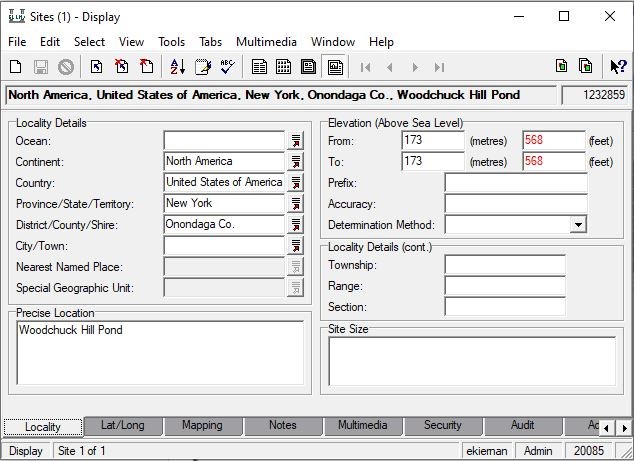
Example of a filled-out Locality tab
See also Geography Exceptions to the Rule
Mapping Tab
Location information may be provided in UTM (Universal Transverse Mercator) format, which consists of a zone number and hemisphere indicator (N or S), an easting coordinate (6 digits), and a northing coordinate (7 digits). UTM information should be recorded in the Mapping Tab, UTM field in this format: UTM: zone numeric value(N/S hemisphere), easting numeric value(E), northing numeric value(N), with spaces separating the values (i.e. “UTM: 12S 0520951E 4419038N”). Often, the hemisphere indicator is not provided; if not, please record the zone value as is without indicating hemisphere. Also, occasionally a letter alternate to hemisphere indicator (N/S) is provided at the end of the zone value, i.e. T; if this happens, please include that value with the zone (i.e. "UTM: 20T 0413898E 4980532N"). If datum is provided, include that information at the end of the text string after a comma (i.e. “UTM: 12S 508473E 4503556, NAD27”). Occasionally, the zone is not provided. When this happens, please record empty brackets ("[ ]") before the easting and northing values in the UTM field (i.e. “UTM: [ ] 0520951E 4419038N”). The easting and northing values should also be recorded in the Easting and Northing fields under the Mapping Co-ordinates section.
You may see UTM values recorded in alternate formats, such as “UTM - 508473 m.E by 4503556 m.N (Zone 12S, NAD 27”). In instances like this, you should omit the unit "m.," delete the space between value/direction for each coordinate value, and retain the datum information (NAD27) separated by a comma after the string (i.e. “UTM: 12S 508473E 4503556, NAD27”). Primary contact for questions or concerns: Liz Gjieli, egjieli@nybg.org.
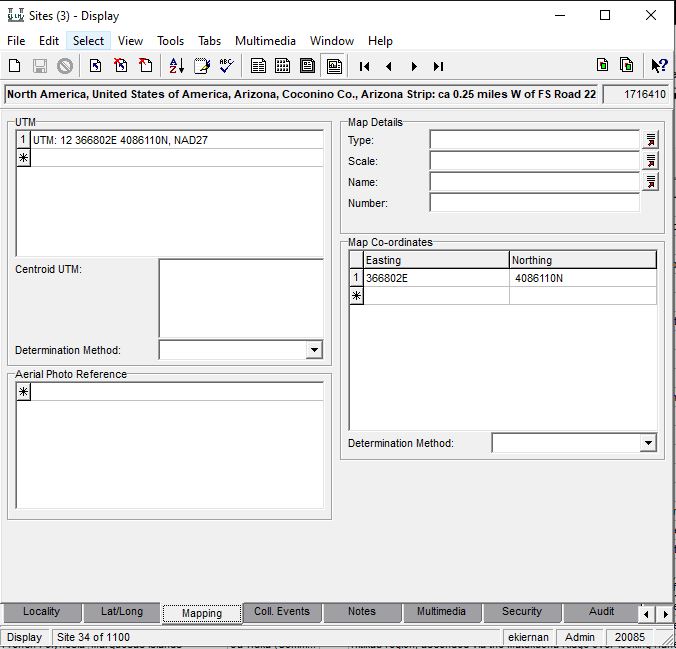
Recording UTM values in the Mapping tab.
Lat/Long Tab
Latitude Longitude Coordinates provided on label
If latitude and longitude coordinates are provided in decimal degrees (-22.00, -42.05) or degrees minutes seconds (22° 00' 29" S, 42° 03' 35" W), input the values in Latitude/Longitude Details field in the appropriate section, Latitude/Longitude (Dec.) or Latitude/Longitude (DMS), respectively. EMu automatically converts coordinate values between the two formats, so either format is acceptable.
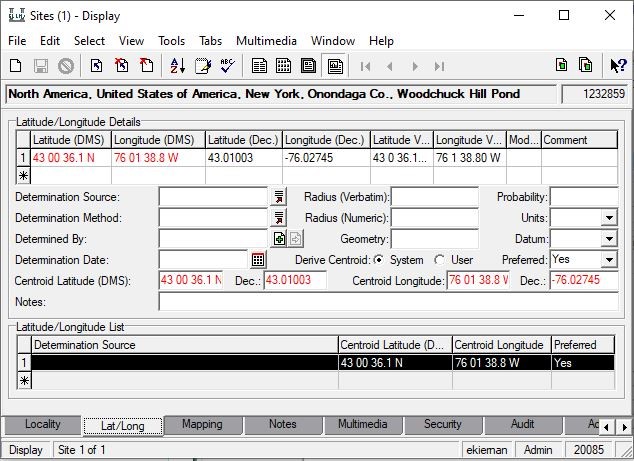
How to record geo-coordinates provided on a specimen label in the Lat/Long table.
Coordinates determined by georeferencing locality
For the following fields used for metadata capture, please do your best to use one of the terms provided in the drop-down list. If you are unsure what to record, or if you need information on best practices, please contact Liz Gjieli, egjieli@nybg.org.
Determination Source: Source of the coordinates, or tools used by the georeferencer to locate the collection site. This includes Google Maps, Google Earth, GeoLocate, MaNIS Georeferencing Calculator, paper maps, gazetteers, etc.
Determination Method: Protocols to determine coordinates. List the georeferencing protocols followed; this is normally a reference guide (Georeferencing Quick Reference Guide, Biogeomancer Guide to Best Practices for Georeferencing, etc.) or an online coordinate conversion tool if coordinates were provided on the label in a format other than decimal degrees or degrees minutes seconds.
Determined By: georeferencer's name (Parties record)
Determination Date: date (short-cut for today's date: CTRL ; )
Radius (Numeric): Uncertainty radius, in meters.
Units: m
Datum: WGS84 (datum used by Google Maps, Google Earth, GeoLocate, Bing Maps, OpenStreetMap, etc.)
Notes: Please enter concise notes on the methods and steps taken to locate coordinates and/or radial for the locality. There is a georeferencing notes template document which provides sample of georeferencing notes to be used per each locality type.
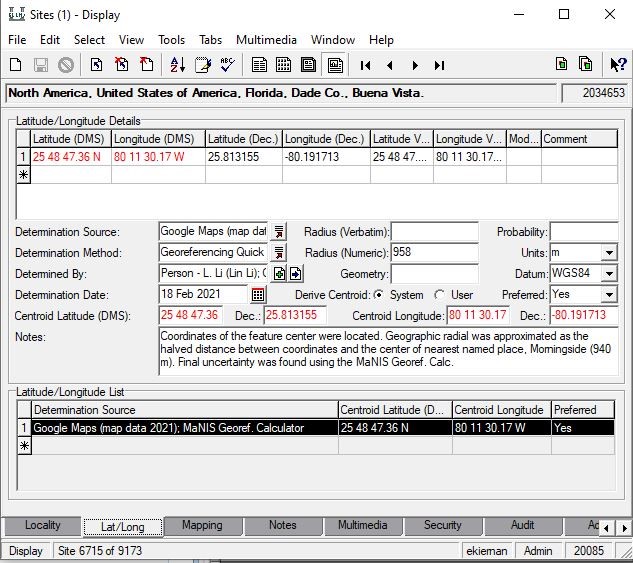
Example of a completed georeferenced Sites record
If unable to georeference (unable to pinpoint the locality or specimen is cultivated), this must be documented. Please include the georeferencer’s name, date, determination method (if applicable), and in the Notes field include reasoning as to why the location cannot be determined.
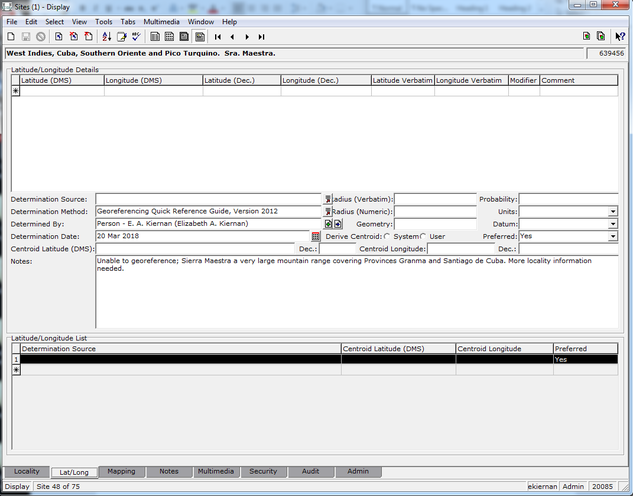
For more information on georeferencing How to georeference collection localities
Notes Tab
This tab is to be used sparingly. Please ensure that the information entered into this field is pertinent to the Collection Event/Catalogue record(s) associated with that specific Sites record. Please also note that this field is not for the capture of georeferencing remarks, which are to be entered in the Lat/Long tab, Notes field.
GEOLocate Tab
Coming soon!